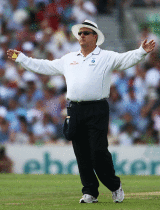
|

Wide of the mark: Ian Howell had a dreadful time at Trent Bridge, and has made plenty of mistakes at The Oval as well
© Getty Images
|
|
It is a pity that matters outside bat and ball should continue to spoil what has so far been wonderful advertisement for Test cricket. The first Test was decided by the weather, and the second, which was won by a skilful and determined performance by the Indians, was overshadowed by jelly beans, player behaviour and inconsistent umpiring. And it will be a tragedy if umpiring becomes a decisive factor in this Test.
Umpires deserve plenty of sympathy. Theirs is a thankless vocation and they are noticed only for their mistakes. Their actions are judged and damned by experts, journalists, and millions of viewers who now have the benefit of hugely sophisticated cameras and technologies such as Snickometer and Hotspot. But still, it's not that difficult to tell when an umpire is not up to it.
Simon Taufel, who invited the wrath of Indian supporters for denying Sachin Tendulkar and Sourav Ganguly well-earned hundreds at Trent Bridge, is a good umpire who had an ordinary match. But it is difficult to say the same about his colleague in that Test. Ian Howell had a dreadful match at Trent Bridge, and it has only got worse at The Oval. It can be considered poor taste to pun on someone's name, but given the number of howlers he has made in the last two Tests, Howell has brought it upon himself.
The ICC has a system in place to assess every decision an umpire makes during a match, and it is often trotted out that umpires get over 90 per cent of the decisions right. Of course, considering that they track every appeal and that teams are appeal-happy these days, Howell might still end up with fairly high percentage. But to anybody who has followed his finger, Howell has got more decisions wrong than right when it really mattered.
Few things can be worse for cricketers, batsmen and bowlers alike, than to play in the knowledge that their fate hangs in the hand of an adjudicator who is consistently inconsistent. There are not-outers, none more famous than the legendary Dickie Bird, there are those who are trigger-happy - Dave Orchard springs to mind - there are those who are conservative about front-foot lbws and there are ones who are spinner-friendly. In many instances, umpires go by the pitch, and are likely to adjudge lbws on the basis of bounce. At Perth, for instance, batsmen can leave the ball on its length, safe in the knowledge that it will sail over the stumps.
But how safe can a batsman feel when faced with Howell? Apart from his obvious tendency to give wrong decisions, it has been impossible to detect a pattern with Howell. May be it lies in his approach to tailenders. This morning he was happy to give Monty Panesar on the forward stretch against Anil Kumble. Panesar had no reason to quibble; he was dead in front. But on what account did he spare Paul Collingwood on the third day? Collingwood's front foot was perhaps a few inches ahead, but as Ian Chappell remarked on television, if that wasn't out, they might as well remove lbw as a mode of dismissal. And when he did give Collingwood out, the ball looked, irrespective of what you saw on Hawk-Eye, to be sliding past the leg stump.
At Trent Bridge, he denied Panesar two lbws in his first two overs in India's first innings. They were vital decisions, for they allowed Dinesh Karthik and Wasim Jaffer to swell the first-wicket partnership to 147, but he was happy to send back RP Singh and Sreesanth in quick succession: Singh looked out, but Sreesanth deserved the benefit of doubt.
It's futile labouring the point, but the lbw that he handed out to Ganguly has perhaps been the shocker of the series. Admittedly, the ball has been swinging exaggeratedly, sometimes changing path after passing the batsman. But this was a deviation palpably off the bat. If he didn't hear the nick, he should have seen it. Was he late in looking up? If he was, it was a schoolboy error from an international umpire.
Which raises the next question. Should Howell have been standing in the series in the first place? Of course, the ICC cannot be blamed for not anticipating the errors, but Howell is not part of the elite panel, and since no other international cricket is on at the moment, those appointing umpires had a full list to choose from. Were none of them available?
It is sad that umpires rarely get the credit for a job well done. In that, they are like wicketkeepers. Matt Prior has become the object of ridicule after two bad matches; it's only fair that the heat is now turned on Howell.
Should umpire Ian Howell, who is not part of the ICC's Elite panel, have stood in the Oval Test? Tell us here Sambit Bal is the editor of Cricinfo and Cricinfo Magazine

